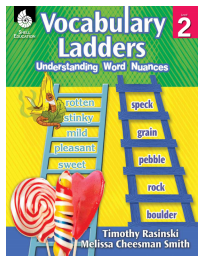
Why focus on Vocabulary?
Vocabulary are words that make up a language. Students are expected to learn and apply vocabulary knowledge in order to make meaning from their learning. Current research indicates that vocabulary knowledge influences other components of literacy instruction such as reading comprehension. A student’s understanding of what they read is closely tied to their vocabulary knowledge. (Flanigan et al. 2012)
Effective Vocabulary Instruction
Word knowledge can be improved through implementing the following principles into vocabulary instruction:
Provide student choice when creating vocabulary lists- This will empower students and promote engagement in the learning process. One suggestion is to use a Vocabulary Rating Scale which provides student ownership in their learning through rating their knowledge of each meaning of the word. Click on the following for examples of scales and template: Vocabulary Rating Scale Vocab Rating Template Additionally, here is a link to view a video from the teaching channel to learn about how one teacher incorporates student choice during vocabulary development: https://www.teachingchannel.org/videos/strategy-to-build-student-vocabulary
Give multiple exposures to new words- This will maximize a deep understanding of vocabulary and aids in retention of learned words. Learning the words in context is important as well as using specific strategies such as the Frayer Model- 4 square and Concept Circles to further word knowledge. The Frayer model uses attributes and non-attributes for word learning. This strategy should be used with the most important vocabulary within a unit of study because it does take time to complete but students learn words thoroughly. Click here for template: Frayer-Four Square . Concept Circles is a strategy that allows for word flexibility and higher-order thinking when classifying and organizing academic vocabulary. Generally, it is quick and easy to implement compared with other vocabulary strategies. Click here for an example: Concept Circles Strategy
Explicit instruction of vocabulary in context- When teaching explicitly, the goal is the make the thinking process “visible” to students so they can “see” how to think about word learning. Please review the following blog on how one 3rd grade teacher shares how she teaches vocabulary using explicit instruction: http://www.readingrockets.org/blogs/common-core-classroom/55272
Provide opportunities for academic conversations- Allow students to work in groups and have discussions using their academic vocabulary. This promotes active learning in students through identifying words/topics important in their own thinking, making connections, and practice using words in correct contexts. Click on the video from the teaching channel to learn how one teacher implements an interactive activity to promote interaction among students: https://www.teachingchannel.org/videos/middle-school-vocabulary-development
Learn the connection between phonemic awareness, the alphabetic principle, and vocabulary knowledge –Some research has found evidence that phonemic awareness and knowledge of the alphabetic principle has the ability to influence children’s learning of new vocabulary words (Ehri, 2005).
Vocabulary for Diverse Learners
Research by Flanigan et al. (2012) cites that approximately 70% of U.S. students in grades 4-12 struggle to read on grade level. This reveals that the majority of our students cannot read with “adequate accuracy, fluency, and comprehension” (p.132) at their grade level. In relation to vocabulary knowledge, these struggling readers may be thousands to ten thousands of words behind when compared to students in a general education setting. This vocabulary gap has staggering effects on academic progress as students strive to succeed year after year. How best do we serve our diverse learners in building their vocabulary knowledge?
Use the vocabulary principles outlined above as well as the following:
- Consider teaching generative vocabulary instruction. See attached articles on ways to teach morphology: What’s in a Word article Root Awakening article
- Research by Ebbers & Denton (20008) indicate that using context clues to support vocabulary knowledge is NOT an effective approach for diverse learners.
- Avoid having students look up words in a dictionary only. Relying on rote memorization is a “bankrupt proposition”, especially for diverse learners and students receiving special education services.
Other vocabulary related resources:
- Check out Tim Rasinski’s website to learn more about reading vocabulary strategies to help retain and apply new words and meanings.
. 
- vocabulary spellingcity.com
- Brunn Article- Four-square strategy
- Morphing into Adolescents Arctile